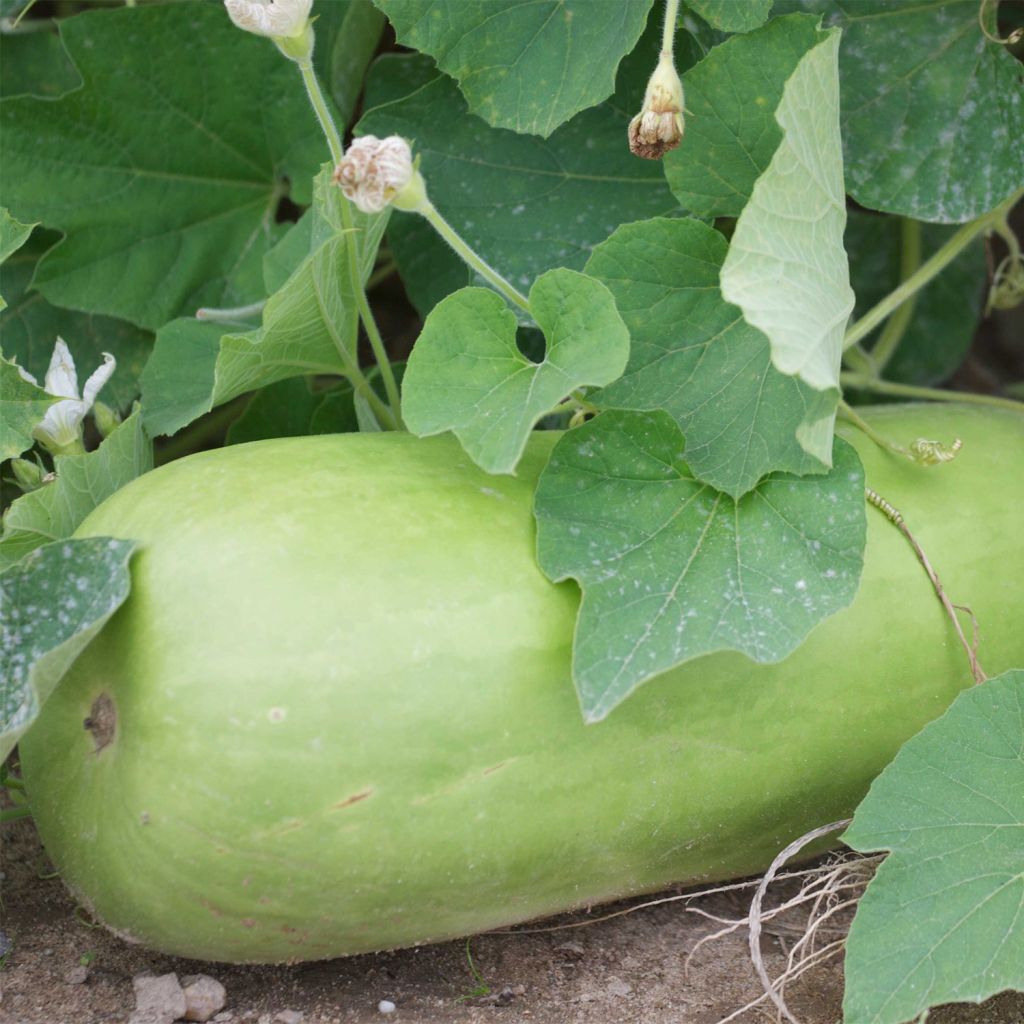Plantfit
Log in / Register
Existing customer?
New customer?
Create an account to track your orders, access our customer service and, if you wish, make the most of our upcoming offers.
My Account
Hello
Shipping country and language
Your country of residence may be:
For a better user experience on our website, you can select:
Your shipping country:
Andorra
Austria
Belgium
Bulgaria
Croatia
Czechia
Denmark
Estonia
Finland
France
Germany
Greece
Hungary
Iceland
Ireland
Italy
Latvia
Lithuania
Luxembourg
Monaco
Netherlands
Poland
Portugal
Romania
Slovakia
Slovenia
Spain
Sweden
Switzerland
Language:
French
English


Courge Massue Bio - Ferme de Sainte Marthe


Courge Massue Bio - Ferme de Sainte Marthe
Organic Club Calabash - Ferme de Sainte Marthe seeds
Lagenaria siceraria Massue
Bottle Gourd, White-flowered Gourd, Calabash, Long Melon
Order in the next for dispatch today!
Dispatch by letter from 3,90 €.
Delivery charge from 5,90 € Oversize package delivery charge from 6,90 €.
More information
This item is not available in your country.
Shipping country:
 Andorra
Andorra Austria
Austria Belgium
Belgium Bulgaria
Bulgaria Croatia
Croatia Czechia
Czechia Denmark
Denmark Estonia
Estonia Finland
Finland France
France Germany
Germany Greece
Greece Hungary
Hungary Iceland
Iceland Ireland
Ireland Italy
Italy Latvia
Latvia Lithuania
Lithuania Luxembourg
Luxembourg Monaco
Monaco Netherlands
Netherlands Poland
Poland Portugal
Portugal Romania
Romania Slovakia
Slovakia Slovenia
Slovenia Spain
Spain Sweden
Sweden Switzerland
SwitzerlandSelect delivery date,
and select date in basket
This plant carries a 6 months recovery warranty
More information
We guarantee the quality of our plants for a full growing cycle, and will replace at our expense any plant that fails to recover under normal climatic and planting conditions.
Description
The Bottle Gourd, also commonly known as the Calabash, is a non-edible variety intended solely for decoration. It produces beautiful pale green fruits that are 40 to 80cm (16 to 32in) tall and 10 to 20cm (4 to 8in) in diameter at the base, resembling a large club. This trailing variety produces 4 to 6 fruits per plant. Once dried, it is often used to make musical instruments or toys for children. Sow it from April to June to harvest it from September to November.
The Bottle Gourd is a herbaceous plant belonging to the Cucurbitaceae family. It is a distant cousin of the squashes, pumpkins, and gourds that we are familiar with. Often called a gourd or bottle gourd, its ornamental fruits have a plethora of uses once dried. Bottle gourds can be found in Asia, Africa, and the Americas. It is an annual creeping or climbing plant thanks to its tendrils. Its leaves are widely pubescent and produce a fairly characteristic smell. In spring, after flowering with large white flowers, it produces round fruits, or with a neck resembling a bottle or amphora. Some varieties can be consumed when very young, like zucchinis. However, some are toxic and therefore not edible. On the other hand, when harvested much later, all bottle gourds can become kitchen utensils, musical instruments like the Kora - an African harp - or the Berimbao accompanying Capoeira fighters in Brazil, candle holders, containers for mate tea etc. This is only possible when the fruit has completely dried and the flesh has disappeared. Bottle gourds can also be used to adorn trellises and pergolas.
Harvesting: Bottle gourds are fruits that need a lot of sun to give their best, like any plant originating from tropical regions. For consumption as a vegetable, the fruit will be harvested when immature with a slightly tender skin. The taste of bottle gourds is not very pronounced, but it is an experience to try if they are edible. To make utensils, you will need to wait until the peduncle has completely dried. Harvesting should be done as late as possible.
Storage: If they are harvested for consumption, the skin must still be tender, and the fruits will only keep for a few days in the vegetable compartment of the refrigerator. Once completely dry, bottle gourds can be stored indefinitely. They can be carved, painted, or pierced, etc. It's up to you to use your imagination to make them into the object that suits you. When dry, they become very fragile, so handle them with care.
Gardener's tip: Bottle gourds should remain on the plant for as long as possible, but bad weather can also cause them to rot. In that case, you can dry them indoors by hanging them. They are generally vigorous plants with very decorative fruits and flowers. Provide them with a trellis so that they can climb, sprawl, and let their fruits droop like lanterns. Bottle gourds do not like moisture, so make sure to give them only the bare minimum in the summer.
Harvest
Plant habit
Foliage
Botanical data
Lagenaria
siceraria
Massue
Cucurbitaceae
Bottle Gourd, White-flowered Gourd, Calabash, Long Melon
South Africa
Annual
Planting and care
The seeds of gourd plants need well-drained soil that is rich in organic matter. They also require plenty of sunlight but minimal water for optimal fruit growth.
For early cultivation: In March or April, sow your seeds in groups of two or three in trays or pots filled with soil that is rich in organic matter. Lightly cover the seeds and then water them to maintain a slight moisture level. The germination process is fairly quick, with seedlings appearing after about ten days. Once they are strong enough and the risk of frost has passed, transplant them into well-prepared soil outdoors. Each plant requires a lot of space, so if possible, space them 1 metre (3 feet) apart. Dig holes that are 20 to 25cm (8 to 10in) deep and fill them two-thirds full with compost. Place the seedling in the hole and cover it with soil, then tamp it down firmly. Keep your seedlings at a temperature of 20°C (68°F). Gourd plants thrive in heat.
For seasonal cultivation: Once the risk of frost has passed, sow two to three seeds in holes that are 2 to 3cm (1in) deep. Gently tamp down the soil and wait about ten days for the first shoots to appear. Make sure to space your holes apart beforehand. Gourd plants look very aesthetically pleasing when grown on trellises or pergolas. As the fruits develop, provide support or train them along the trellis. Harvesting can begin as early as July for consumption as vegetables. They should be picked when still immature. Gourds for decorative purposes, on the other hand, should be harvested in autumn as late as possible. A simple method to determine the optimal harvesting time is to observe the stem: if it is completely dry and the fruit is ready to detach itself, then it is time to harvest. Fully dried gourds will change colour. However, if your autumns are wet, feel free to harvest and dry the fruits indoors.
Seedlings
Care
Intended location
This item has not been reviewed yet - be the first to leave a review about it.
Haven't found what you were looking for?
Hardiness is the lowest winter temperature a plant can endure without suffering serious damage or even dying. However, hardiness is affected by location (a sheltered area, such as a patio), protection (winter cover) and soil type (hardiness is improved by well-drained soil).

Photo Sharing Terms & Conditions
In order to encourage gardeners to interact and share their experiences, Promesse de fleurs offers various media enabling content to be uploaded onto its Site - in particular via the ‘Photo sharing’ module.
The User agrees to refrain from:
- Posting any content that is illegal, prejudicial, insulting, racist, inciteful to hatred, revisionist, contrary to public decency, that infringes on privacy or on the privacy rights of third parties, in particular the publicity rights of persons and goods, intellectual property rights, or the right to privacy.
- Submitting content on behalf of a third party;
- Impersonate the identity of a third party and/or publish any personal information about a third party;
In general, the User undertakes to refrain from any unethical behaviour.
All Content (in particular text, comments, files, images, photos, videos, creative works, etc.), which may be subject to property or intellectual property rights, image or other private rights, shall remain the property of the User, subject to the limited rights granted by the terms of the licence granted by Promesse de fleurs as stated below. Users are at liberty to publish or not to publish such Content on the Site, notably via the ‘Photo Sharing’ facility, and accept that this Content shall be made public and freely accessible, notably on the Internet.
Users further acknowledge, undertake to have ,and guarantee that they hold all necessary rights and permissions to publish such material on the Site, in particular with regard to the legislation in force pertaining to any privacy, property, intellectual property, image, or contractual rights, or rights of any other nature. By publishing such Content on the Site, Users acknowledge accepting full liability as publishers of the Content within the meaning of the law, and grant Promesse de fleurs, free of charge, an inclusive, worldwide licence for the said Content for the entire duration of its publication, including all reproduction, representation, up/downloading, displaying, performing, transmission, and storage rights.
Users also grant permission for their name to be linked to the Content and accept that this link may not always be made available.
By engaging in posting material, Users consent to their Content becoming automatically accessible on the Internet, in particular on other sites and/or blogs and/or web pages of the Promesse de fleurs site, including in particular social pages and the Promesse de fleurs catalogue.
Users may secure the removal of entrusted content free of charge by issuing a simple request via our contact form.
The flowering period indicated on our website applies to countries and regions located in USDA zone 8 (France, the United Kingdom, Ireland, the Netherlands, etc.)
It will vary according to where you live:
- In zones 9 to 10 (Italy, Spain, Greece, etc.), flowering will occur about 2 to 4 weeks earlier.
- In zones 6 to 7 (Germany, Poland, Slovenia, and lower mountainous regions), flowering will be delayed by 2 to 3 weeks.
- In zone 5 (Central Europe, Scandinavia), blooming will be delayed by 3 to 5 weeks.
In temperate climates, pruning of spring-flowering shrubs (forsythia, spireas, etc.) should be done just after flowering.
Pruning of summer-flowering shrubs (Indian Lilac, Perovskia, etc.) can be done in winter or spring.
In cold regions as well as with frost-sensitive plants, avoid pruning too early when severe frosts may still occur.
The planting period indicated on our website applies to countries and regions located in USDA zone 8 (France, United Kingdom, Ireland, Netherlands).
It will vary according to where you live:
- In Mediterranean zones (Marseille, Madrid, Milan, etc.), autumn and winter are the best planting periods.
- In continental zones (Strasbourg, Munich, Vienna, etc.), delay planting by 2 to 3 weeks in spring and bring it forward by 2 to 4 weeks in autumn.
- In mountainous regions (the Alps, Pyrenees, Carpathians, etc.), it is best to plant in late spring (May-June) or late summer (August-September).
The harvesting period indicated on our website applies to countries and regions in USDA zone 8 (France, England, Ireland, the Netherlands).
In colder areas (Scandinavia, Poland, Austria...) fruit and vegetable harvests are likely to be delayed by 3-4 weeks.
In warmer areas (Italy, Spain, Greece, etc.), harvesting will probably take place earlier, depending on weather conditions.
The sowing periods indicated on our website apply to countries and regions within USDA Zone 8 (France, UK, Ireland, Netherlands).
In colder areas (Scandinavia, Poland, Austria...), delay any outdoor sowing by 3-4 weeks, or sow under glass.
In warmer climes (Italy, Spain, Greece, etc.), bring outdoor sowing forward by a few weeks.